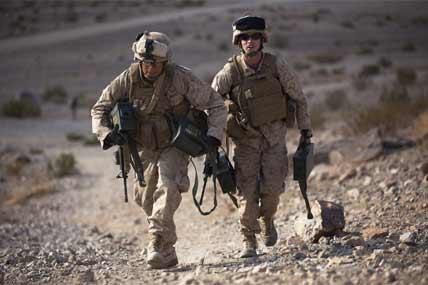A decade of war has the Marine Corps implementing a change that will see collective battalion- and squadron-level training for Marines headed off to the combat theater.
What the Corps is calling Integrated Training Exercise, or ITX, is succeeding the Enhanced Mojave Viper program. ITX is the latest training program in a series of programs that have evolved since the U.S. went to war in Afghanistan and Iraq.
"It is essentially a melding of the [Marine Air-Ground Task Force]," said Col. Kip J. Haskell, commanding officer of Technical Training Exercise Control Group, in a statement.
He said it will consist of 129 integrated events encompassing ground, logistics and air combat elements.
The change will help put the Corps back into position to fight in any kind of contingency after more than 11 years of combat in a primarily counter-insurgency fight.
ITX will include many of the same training objectives of Enhanced Mojave Viper – that is, to fight and win in Afghanistan – though training will also embrace support of contingency operations for unit deployment programs and Marine Expeditionary Units, he said.
Marine Corps leaders included ITX in its training road map for how it will meet its future mission requirements. ITX is intended to provide a battalion or squadron level a collective training experience to practice skills necessary to meet the Corps' mission essential tasks. It will also serve as a service-level assessment of a unit, officials said.
Introducing ITX is not the only training change envisioned by the Marine Corps, said Maj. Gen. Thomas M. Murray, commander of Training and Education Command, or TECOM.
In a recent interview with Military Training Technology, Murray identified ITX as one of several new programs and initiatives TECOM anticipates implementing in the next few years.
There will also be a Battle Staff Training Program for battle-staff Marines across the MAGTF, from battalion and squadron to MEF-level headquarters. The Corps will also execute a large-scale – brigade-level or higher – combined arms exercise that will employ distributed forces in a live/virtual training construct linked via network across the U.S.
Finally, the Corps is planning a mountain exercise to focus on the technical aspects of mountain and cold weather ops and the tactical integration of MAGTF elements from battalion level on down. The mountain exercise would be conducted at the Marine Corps Mountain Warfare Training Center in California as well as the Hawthorne Army Depot and Naval Air Station Fallon in Nevada.
Murray told the publication that the new MAGTF training programs are "an important step towards refocusing our Corps on its core capabilities and posturing our forces to meet operational requirements across the entire range of military operations."
Since 2001, the Combat Center has provided training for combat operations in the Middle East. Training exercises have evolved from the Combined Arms Exercise to what is known today as Enhanced Mojave Viper and now ITX.
In the release, Haskell said the Tactical Training Exercise Control Group at Twentynine Palms is completing the requirements to build, publish and execute those mission-essential tasks contained in the ITX exercise design
"As the requirements and missions for the Marine Corps changed during Operation Iraqi Freedom and Operation Enduring Freedom [in Afghanistan], so did the training requirements and support" for previous training evolutions going back to the Combat Arms Exercise, Marine officials said.
The Combat Army Exercise began in 1975 as a 23-day long training program in essential combat skills that allowed for brigade- and battalion-sized live-fire and maneuver exercises.
Revised CAX was introduced in 2004 to prepare Marines for duty in Iraq. That meant large-scale battlefield scenarios were dropped from the training in lieu of skills required for occupation.
With subsequent changes, the training was dubbed Mojave Viper and then Enhanced Mojave Viper, increasingly oriented toward Afghanistan.
"EMV's greatest contribution to the Corps was preparing Marines to fight and win in OEF," Haskell said in the Corps release. "And the integrations of the MAGTF into a combined arms full spectrum exercise that can fight and win in any future contingency operation."
The new program will still prepare Marines for Afghanistan, but better position them to fight and win across a range of environments and climates, Marine officials said.
"The nature of modern-day war continually changes," he said in the release. "With that, the Corps must rise to the occasion and adapt and overcome. The Combat Center and MAGTFTC are ensuring Marines stay one step ahead of the enemy."


























